Click on images to enlarge
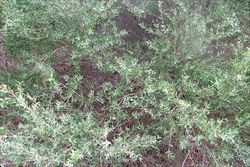
dense infestation on a coastal sand dune (Photo: Sheldon Navie)
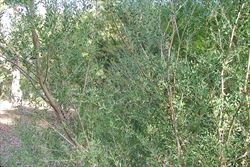
habit (Photo: Sheldon Navie)
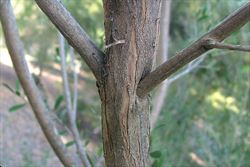
thin bark on main stem (Photo: Sheldon Navie)
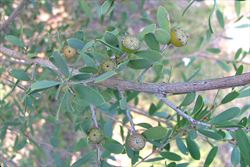
branches, leaves and immature fruit (Photo: Sheldon Navie)
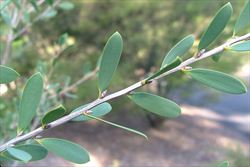
close-up of younger stem and leathery leaves (Photo: Sheldon Navie)

new growth sparsely covered in silky hairs (Photo: Sheldon Navie)

flowers and young fruit (Photo: Sheldon Navie)
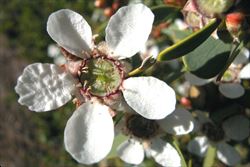
close-up of flower with five broad petals and numeorus small stamens (Photo: Greg Jordan)
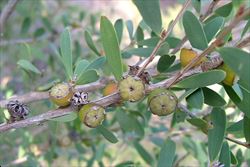
immature fruit (Photo: Sheldon Navie)
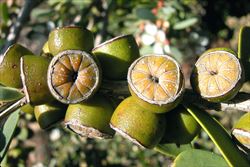
close-up of immature fruit (Photo: Greg Jordan)
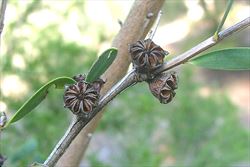
mature woody fruit with several small compartments (Photo: Sheldon Navie)
Scientific Name
Leptospermum laevigatum (Gaertn.) F. Muell.
Synonyms
Fabricia laevigata Gaertn.
Family
Myrtaceae
Common Names
Australian myrtle, Australian tea tree, Australian teatree, coast tea-tree, coast teatree, coastal tea tree, coastal tea-tree, Victorian tea-tree
Origin
Native to south-eastern Australia (i.e. the coastal districts of New South Wales, eastern Victoria and north-eastern Tasmania).
Cultivation
Widely cultivated as a garden ornamental, as a windbreak or hedging plant, for the stabilisation of sandy soils, and in rehabilitation areas where sand-mining has occurred.
Naturalised Distribution
Widely naturalised, particularly in coastal districts, that are beyond its native range in southern and south-western Australia (i.e. in central and western Victoria, south-eastern South Australia and south-western Western Australia). Also occasionally naturalised in south-eastern Queensland and beyond its native range in the coastal districts of north-eastern New South Wales.
Naturalised overseas in New Zealand, southern Africa, south-western USA (i.e. California) and Hawaii.
Habitat
A weed of coastal sand dunes and cliffs, coastal heathlands and occasionally also dry sclerophyll forests in temperate and sub-tropical regions.
Habit
A shrub or small tree usually growing 2-4 m tall, but occasionally reaching up to 6 m in height.
Distinguishing Features
-
a shrub or small tree growing up to 6 m in height.
-
its older stems are covered in thin brown bark that is shed in long strips.
-
its small leathery leaves (15-30 mm long) are sparsely covered in silky hairs when young.
-
its white flowers (15-20 mm across) are usually arranged in pairs in the upper leaf forks.
-
these flowers have five white petals and numerous stamens that are borne on the top of a swollen base.
-
its flat-topped woody fruit (7-8 mm across) have 6-11 small compartments.
Stems and Leaves
Older stems are covered in thin brown bark that is shed in long strips. Younger stems are smooth, greenish in colour, and somewhat silky hairy, but quickly become hairless (i.e. they are glabrescent).
The leathery leaves are borne on very short flattened stalks (i.e. petioles) and are alternately arranged along the stems. These relatively small leaves (15-30 mm long and 5-8 mm wide) are usually narrowly egg-shaped in outline with broad tips (i.e. narrowly-obovate), but end in a small point (i.e. they are mucronate). They have entire margins and are quickly hairless (i.e. glabrescent), though they may be sparsely covered in silky hairs when young.
Flowers and Fruit
The flowers (15-20 mm across) are usually arranged in pairs in the upper leaf forks (i.e. axils) and are borne on short branches. Each flower has five broad white petals (5-8 mm long) and five smaller sepals (about 2 mm long), which are borne on the top of a swollen base (i.e. hypanthium). These flowers also have numerous stamens (1.5-2.5 mm long) and an ovary topped witha style and stigma. Flowering occurs mostly during late winter and spring (i.e. from August to October).
The flat-topped fruit (usually 7-8 mm across) turn from green to brown in colour and become woody in nature as they mature. These fruit have 6-11 small compartments containing several small seeds (about 2.5 mm long). The seeds are irregularly-shaped with patterned (i.e. reticulate) surfaces and are usually somewhat winged.
Reproduction and Dispersal
This species reproduces by seed, which are commonly dispersed by wind and water. Seeds are also spread in dumped garden waste and through the deliberate cultivation of this species in areas outside its native range.
Environmental Impact
Coastal tea-tree (Leptospermum laevigatum ) is regarded as a significant environmental weed in Victoria and Western Australia, and as an environmental weed in South Australia. This species is actively managed by community groups in Western Australia and was recently listed as a priority environmental weed in at least one Natural Resource Management region.
Legislation
Not declared or considered noxious by any state government authorities.
Similar Species
Coastal tea-tree (Leptospermum laevigatum) is similar to several other native tea-trees (Leptospermum spp.), however it can usually be distinguished by the fact that its woody fruit have 6-11 compartments (most other species have fruit with less than seven compartments).

